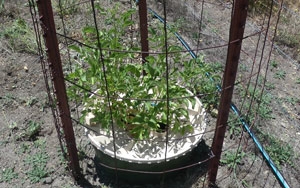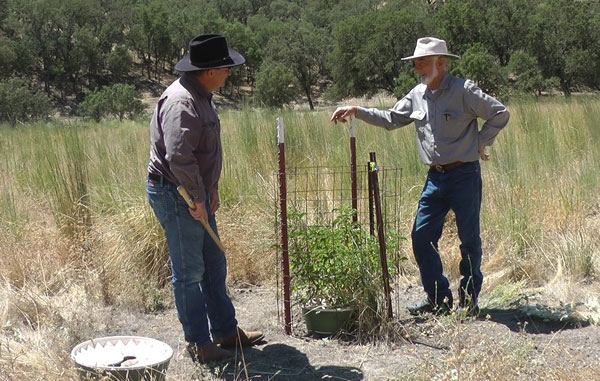
The beauty of rolling hills studded with majestic oaks, other trees and shrubbery isn't the only reason to regenerate vegetation. The trees and shrubs create a much more hospitable habitat for a wide assortment of wildlife. Oak woodland vegetation also protects the quality of California water. The majority of the state's water flows through oak woodlands in streams and rivers that support fisheries, farms and cities. Plants and trees anchor the soil, preventing erosion and stream sedimentation.
One of the difficulties ranchers face in regenerating trees is supplying water for seedling establishment. Ranches often stretch for thousands of acres. Hauling water to remote sites or installing irrigation can be prohibitively expensive.

Third-generation San Miguel rancher George Work heard about a new tree establishment invention from Holland – a Groasis Waterboxx. Over the years, Work has collaborated with UC Cooperative Extension on oak planting projects and consulted with UCCE experts about squirrel diseases, ranch animal vaccinations and pasture management. He turned to UCCE natural resources advisor Royce Larsen for his thoughts on the Waterboxx.
“Because of Royce here, our Cooperative Extension agent, he provided a little added incentive when I wanted to try this thing,” Work said. “Royce said, ‘I'll help you.' Well, that was enough to get the job done.”
Work, Larsen and UC Cooperative Extension natural resources specialist Bill Tietje installed 10 Waterboxxes, which cost about $30 each, in a remote area of the 12,000-acre Work Ranch in southern Monterey County. Other plant regeneration methods – including traditional drip irrigation and tree teepees – were also installed for comparison.
The Waterboxx is a round plastic hat box-shaped reservoir that fits around the seedling trunk. When the seedling is planted, the reservoir is filled with about four gallons of water. A rope on the bottom continuously wicks moisture to the plant roots.
The box is covered with an inward-slanting corrugated top that cools during the night and channels condensed dew and fog into the reservoir, keeping it full of water. The Waterboxx provides a protective barrier around the trunk and shades and cools the soil beneath. At the Work Ranch, the plants are also enclosed in bale-wire fence to keep out wildlife poking around for water or hungry for tender green growth.
“The trees are doing surprisingly well," Larsen said. "In just three months, the seedlings have grown more than two feet."
Larsen said he will continue monitoring the project to see if the self-watering system can establish trees. If successful, UC scientists may study the Waterboxx more thoroughly in a replicated research design in Monterey County, San Luis Obispo County and other parts of the state.
See the components of a Waterboxx in the video clip below.
Attached Files: